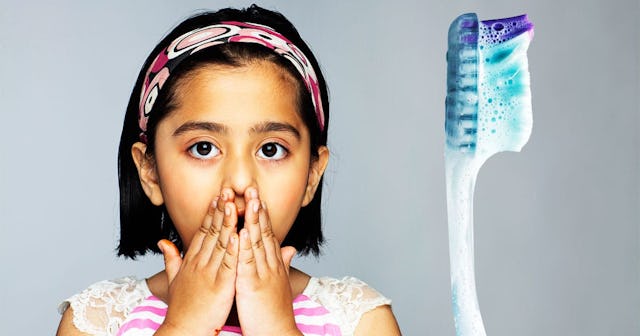My 6-Year-Old Had Multiple Cavities -- And Not Because I Am A 'Lazy Parent'

My daughter was eating dinner—chicken, applesauce, and rice—when her tooth pain began. “I can’t eat this,” she whined. “My mouth hurts,” she said.
But I dismissed her discomfort, assuming she was bored and wanted permission to get up. She wanted to play on her tablet or watch TV. I chalked the supposed ache in her mouth up to avoidance. She didn’t want to eat non-snack foods or to try her veg—which, on this particular evening, was a small side of broccoli. And I believed the pain was conveniently timed. She would skip dinner and go straight to dessert. But when my daughter cried during bath time, when she screamed while brushing her teeth, I knew the truth: My daughter had a cavity.
Scratch that: A quick trip to the dentist revealed my six-year-old had several cavities.
Of course, when the dentist told me my daughter had five cavities, I was embarrassed and ashamed. How could this happen? I wondered. She cleans her teeth every morning. I help her brush every night. I also felt defensive.
“She doesn’t drink a lot of juice,” I said. “We limit her to one treat each night.”
But her dentist explained some children are more prone to cavities than others. “Genetics plays a role,” she told us. Pediatric cavities are also relatively common. By age five, for example, about 60 percent of U.S. children will have experienced tooth decay, a 2014 American Academy of Pediatric Dentistry report explains.
So what causes cavities and/or tooth decay, which—according to Johns Hopkins—“is the breakdown, or destruction, of tooth enamel?” While poor oral hygiene can increase your child’s risk for tooth decay, all children have bacteria in their mouth, and this bacteria can increase a child’s risk for cavities and decay. Diet can also play a role.
“Certain foods, like carbohydrates and starches, tend to get stuck on and in between our teeth,” Dr. Rhonda Kalasho—a Los Angeles-based dentist—says. “Once there, the bad bacteria that are found in the mouth… take those starches and carbohydrates and break them down releasing an acid byproduct that dissolves the enamel and leads to tooth decay.”
Silvia IPhonephoto/Reshot
Socioeconomic factors also play a role. According to PBS, 44 million Americans are uninsured, another 38 million are inadequately insured — and that’s before the pandemic. Many cannot afford dental care—or any type of healthcare. Those living in rural areas also lack access; in late 2017, Staff Care reported that the Health Resources and Services Administration identified 5,866 dental health professional shortage areas, in which nearly 63 million people live.
There is also a genetic component.
“Enamel thickness and its resilience to decay is genetically inherited,” Kalasho tells Scary Mommy. “According to scientific research, your genetic predisposition to decay makes up 60% of the likelihood of developing decay, and the other 40% is dietary behavior and oral hygiene.”
That said, this news didn’t make me (or my daughter) feel better. The mom guilt was strong, and my daughter’s mouth was throbbing. She held her cheek while watching cartoons and cried while consuming food. What’s more, I felt worse when her dentist told me her treatment plan would include two baby root canals—a process which involves removing the pulp of the tooth and then capping it with a stainless steel crown—and three fillings. Oh, and all of this would transpire over the course of four separate visits and trips.
There would be drills, dental picks, and nitrous oxide.
It would also cost thousands of dollars.
But we went through with the treatment plan, because pediatric cavities need to be treated.
“If cavities are not treated, they can damage permanent teeth,” Dr. Sheila Dobee, a dentist from Your Caring Dentist, says. “They can also cause narrowing of the airways and death.”
We also didn’t want our oldest to be in pain, so we found a way to finance the root canal and fillings. With an FSA and decent dental insurance, my daughter, who is a trooper, pulled through.
There’s such an unfair stigma when it comes to tooth decay in kids — like cavities happen through sheer negligence alone. Obviously, that isn’t the case, and it’s so important to realize that there are all kinds of contributing factors. If our kids have cavities, it says nothing about our worth as parents, and we need to remember that.
As for how we are preventing future cavities, my daughter still brushes twice a day: once every morning and just before bed every evening. She uses a fluoride-rich mouthwash, one which is made specifically for kids and tastes like fresh fruit or bubblegum. And I help her floss, which is not easy in her tiny mouth. But we do so because it is necessary: Correct brushing and flossing is the best way to prevent cavities and tooth decay.
We also monitor what she eats, as we always have. Dr. Dobee advises that decreasing your sugar intake, reducing your acid intake, and eating more fruits and vegetables can help with the development of teeth and having a more balanced micro flora.
Does this mean she will be safe from future tooth decay? Maybe, but probably not. Given the number of cavities my daughter had, her dentist believes she is predisposed to have more. That good ol’ genetic component is likely at play, but we will do our best to keep her healthy and happy. To keep her cavity free.
This article was originally published on